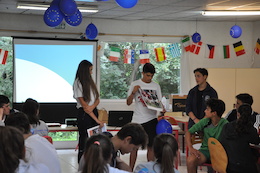Toolbox — For Training and Youth Work
All new tools in your inbox: Be the first to know about new tools for learning with our e-mail notifications.
Exercise
Gender equality in sport
This activity has been created by Marine Lapouze, youth participant in the “Happy twinanniversary to Youth” (Youth Exchange) project coordinated by the twining committee of Angoulême, with Russian, Portuguese, Romanian, Spanish and American partners.
Aims of the tool
Main themes:
- Equality between women and men in sport.
- Representation of women's sport / men's sport.
- The impact of media and pictures
Goals:
- To become aware of the social construction of representations, especially with regard to the female sports.
- To Learn to decode the standards conveyed through the image.
Description of the tool
Preparation / material :
- Chose different posters / picture of women in sport
- Divide the children into several groups
- Provide paper version of the images (one for each group)
Instruction:
1. Make a pinted copy of the selected posters.
2. Arrange the set of images on a table (one table = one group), face up.
3. After reflection between them, each group has to choose two posters according to the following criteria:
a. The poster which corresponds most to their conception of the sportswoman.
B. The poster whixch corresponds least to their conception of the sportswoman.
4. Ask each group to present with a few key words their choice.
Evaluation Report:
Through the analysis of the arguments delivered by the participants, this exercise enables us to identify in sport what constitutes the attributes of masculinity and the attributes of femininity ...
The coordinator has to :
- Explain that the choice of photographs is based on the collective representation of the sportswoman.
- Define precisely the concept of collective representation.
Definition of the collective representation:
It is a common way of perception and knowledge of individual representations. It is to see and understand together, without being reduced, like animals, to living according to the individual perceptions alone.
The coordinator has to initiate a debate:
Is it possible to modify the representation of the sports woman? What can we do?
Debriefing:
The representation of women's sport is already integrated into us ... It is the product of our education. So it can vary according to the population.
The presence of the image participates in the construction of representations. The media disseminate information about a great responsibility in the construction of collective representation.
The representation that one has of a social choice or a fact (like the female sport) is thus changed.
Suggested follow-up:
- Retain this framing "Everything that is socially constructed can be deconstructed".
- Be more alert to the use of images in newspapers, in advertisements and reports ... And the message maintains service.
Available downloads:
Disclaimer
SALTO cannot be held responsible for the inappropriate use of these training tools. Always adapt training tools to your aims, context, target group and to your own skills! These tools have been used in a variety of formats and situations. Please notify SALTO should you know about the origin of or copyright on this tool.
Tool overview

http://toolbox.salto-youth.net/2120
This tool is for
Youth people
and addresses
Social Inclusion, Group Dynamics, Intercultural Learning, Gender issues
It is recommended for use in:
Youth Exchanges
Materials needed:
Computer / Vidéo Projector / Printed Posters
Duration:
2 hours
Behind the tool
The tool was created by
Marine Lapouze
in the context of
European Youth Exchange
The tool has been experimented in
European Youth Exchange
The tool was published to the Toolbox by
Aurore Labarussias (on 21 October 2017)
and last modified
27 September 2017
Comments
No comments have been posted yet.
If you want to comment on this tool, you need to be signed in with your MySALTO account. Sign in now